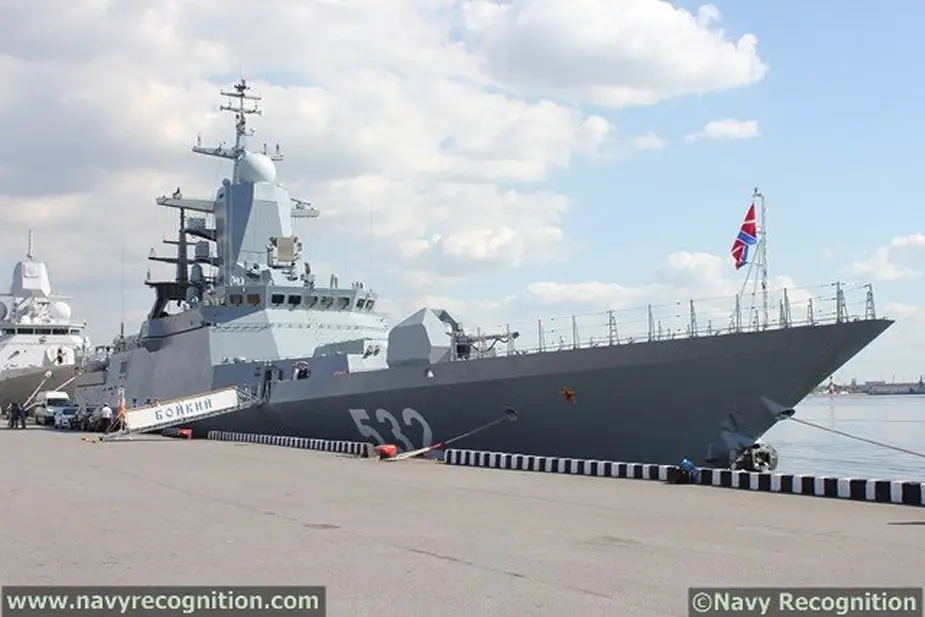The Russian Defense Ministry plans to sum up the results of the arms program for 2011-2020 this year and specify the parameters of the current program for 2018-2027, Deputy Defense Minister Alexey Krivoruchko told the Radio Electronic Technologies magazine.
The Russian Defense Ministry plans to sum up the results of the arms program for 2011-2020 this year and specify the parameters of the current program for 2018-2027, Deputy Defense Minister Alexey Krivoruchko told the Radio Electronic Technologies magazine.
 Steregushchy-class (Project 20380) corvettes Boiky of the Russian Navy Baltic Fleet (Picture source: Navy Recognition)
Steregushchy-class (Project 20380) corvettes Boiky of the Russian Navy Baltic Fleet (Picture source: Navy Recognition)
The Navy receives new warships, submarines and auxiliary vessels. In 2020, the Defense Ministry will for the first time in 28 years receive six submarines, including four Borey-A-class nuclear submarines of project 955 and Yasen-M-class project 885M and two diesel-electric Lada class subs of projects 636.3 and 677.
The Pacific fleet will get the Aldar Tsydenzhapov corvette of project 20380 in 2020 and the Rezky corvette in 2021. They will be the third and fourth corvettes of the project in the fleet. Their main weapon is the antiship Uran missile complex.
The preliminary design of a universal landing ship was completed in 2019. Its technical design will begin in 2020.
Navy renewal demands more modern supply vessels. So far, 152 new vessels became operational according to the 2011-2020 arms program. Four vessels were delivered in the autumn of 2019. The arms procurement order for 2020 and up to 2022 stipulated additional construction of three dredgers and five tankers. 176 sea and harbor auxiliary vessels are to be built according to the 2018-2027 arms program.
The 2011-2020 program is the first in a long time that is fully implementable and ensures a transition to massive supplies of new arms and hardware. It aimed at balancing the strategic nuclear forces, supplying modern and prospective arms to permanent readiness units, creating information control systems and scientific potential for the production of the latest arms and hardware. A set of goal-oriented indicators was designed and approved to timely adjust the work to arm the forces with new weapons.
The 2011-2020 arms program increased the share of new weapons in the Strategic Nuclear Forces to 83%, in the Aerospace Forces – 75%, Airborne Forces and the Navy – 63%, and Ground Forces 50%. The share of modern controls of the troops comprised 67% and the share of modern weapons reached 68% on average. The arms program aimed at bringing the share to 70%. Thus, the program is successfully fulfilled and the potential of all arms and types of the armed forces ensures all assigned missions.
Krivoruchko recalled that the 2011-2020 arms program was launched when the share of modern weapons was close to 20% in the nuclear forces and did not exceed 10% in general forces. The figure comprised 30-50% in the leading foreign armies at the time. In 2019, over 1.5 trillion rubles were earmarked to rearm the army and the navy and over 70% of funds were disbursed to procure modern arms. The troops received over 2,300 units of new and upgraded hardware. The pace of high-tech weapons supply accelerated 6.7% against 2018.
New hardware is supplied synchronously with the construction of the required infrastructure. In 2018, 3,537 buildings and erections with a total space of 3.6 million m² were built or overhauled and reconstructed. In 2019, the construction pace grew 15%. The builders had to commission over 3,750 objects by the end of December. 2,338 of them were commissioned by October 2019. 168 billion rubles were earmarked for infrastructure development in 2019. The construction will continue. The 2018-2027 arms program appropriates one trillion rubles for that.
This year has to demonstrate the effectiveness of budget appropriations into batch production of weapons and hardware.
The new Sarmat RS-28 ICBM is undergoing successful trials. It is to replace the Voevoda heavy missile in the strategic forces. Sarmat delivers reentry vehicles by trajectories which make it difficult to destroy them even for prospective missile defense. The new ICBM strikes at targets at a distance of 18,000 km and has the launch weight of 208.1 tons and a payload of close to 10 tons. The first serial missiles are to be supplied in 2021.
The Aerospace Forces are re-equipping the orbital group of military spacecraft. New monitoring and mapping Bars-M satellite designed by Progress Rocket Space Center is ready for deliveries.
The Russian orbital group currently numbers 150 spacecraft of various designations. Over 90 craft operate for the Defense Ministry. They engage in a broad range of missions - communications, navigation, geodesy, meteorology, Earth remote sensing, monitoring of the situation and scientific research. The quality and reliability of the spacecraft and their element base increased. Previously the life cycle in orbit comprised several months. Now, modern satellites operate for 15 years. The 2018-2027 arms program has to upgrade and renew the orbital group of the Space Forces and protect it from various impacts.
The Aerospace Forces operate over 3,000 aircraft. From 2013 to 2018, they received over 1,000 new and upgraded airplanes and helicopters. They are mostly multirole long-range, tactical jets and helicopters. They include 78 multirole Su-35S fighter jets supplied by the Sukhoi company in 2013-2018.
Strategic Tupolev Tu-95MS, Tu-160 and long-range supersonic Tu-22M3 bombers are being upgraded. They can carry the latest cruise missiles and other prospective air weapons. The construction of the Tu-160M2 strategic bomber is ongoing. The first flight is scheduled in 2021 and deliveries must begin in 2025. Ten bombers have to be procured by 2027.
In 2019, the Defense Ministry approved the final rough design of the Prospective Airborne Complex of Long-range Aviation (PAK DA). The characteristics were agreed and all contract documents signed to produce prototypes. PAK DA flight trials are stipulated by the 2018-2027 arms program. In future the aircraft will replace Tu-95MS.
Batch production of multirole fifth-generation Su-57 fighter jet began in 2019. The Aerospace Forces will receive 76 aircraft by 2028 and fully rearm three air regiments with them. The fighter jets carry modern weapons and have the necessary ground infrastructure. Nothing similar has been done in the past 40 years in Russia in such a volume.
Effective modernization considerably improved the firepower of MiG-31 fighter jet which has to carry Kinzhal complex with a hypersonic ballistic missile.
In 2019, the heavy Ilyushin Il-76MD-90A Candid airlifter was upgraded to meet the requirements of the technical assignment. It is an upgraded Il-76MD produced by the Chkalov aircraft plant in Tashkent.
Flight trials of Il-112V will resume in the first quarter of 2020. It is the first post-Soviet light airlifter designed in Russia from scratch. It will replace the Antonov An-26.
In November 2018, the Defense Ministry approved the technical assignment for prospective medium airlifter which is to replace An-12. Several concepts are being elaborated. In particular, the Ilyushin company considers a rough design of two-engine Il-276 jet. The Tupolev company has its own project. The final choice will be made after a thorough consideration of all proposals.
The helicopter fleet is equipped with modern onboard defense with improved characteristics. The Russian Helicopters Holding handed over to the troops 112 rotorcraft. The Defense Ministry plans to receive 423 modern helicopters, including 96 Mil Mi-28NM gunships by 2027. It is stipulated by the 2018-2027 arms program.
In 2019, the latest Prometei S-500 air defense system underwent trials and launched new missiles which are unprecedented in the world. The new weapon is likely to be ready for deliveries in 2020. Its main mission is to fight intermediate-range ballistic missiles at a distance of 3,500 km and ICBMs at the final stage of the flight and at the middle stage in some cases.
In 2019, acceptance trials of the S-350 Vityaz medium-range air defense weapon were completed. The deliveries are to begin in 2020. The new-generation weapon fights aerodynamic and ballistic targets. It has increased firepower and a bigger stock of missiles which is important in conditions of a massive engagement of precision weapons by the adversary. Vityaz will replace S-300PS and Buk-M1-2.
400 new and upgraded armor units have to be supplied to the Ground Forces. They include T-72B3M tanks with Russian-made sights, T-90M (code Proryv-3), T-80BVM and infantry fighting vehicles BMP-1AM. T-90M Proryv-3 tank has increased protection, automatic fire control and high-power engine. The first tanks have already been supplied. The Ground Forces operate close to 400 T-90 tanks of various modifications. They will all be upgraded according to a contract signed in the summer of 2019.
The Defense Ministry considers the renewal of the tank fleet as a procurement priority. It pays much attention to the creation of the heavy tracked unified Armata platform and T-14 tank, in particular. The tank is in the testing stage. Acceptance trials are to begin in 2020. Heavy T-15 infantry fighting vehicle with Kinzhal combat module and a 57mm gun is designed on Armata platform. Its prototype was demonstrated at Army-2019 forum.
Acceptance trials of Derivatsia-PVO antiaircraft self-propelled gun on BMP-3 undercarriage will continue in 2020. It has an unmanned combat module with a 57mm gun and can fire at ground and air targets. Derivatsia-PVO will fight drones. A line of munitions also with remote detonation was designed for the mission.
The round of Iskander-M munitions will additionally get precision cruise missiles. Air defense units will be armed with long-range guided missiles for S-400.
The rearmament of the Ground Forces enjoys major attention. They received a quarter of the funds of the 2011-2020 arms program and got upgraded T-90AM, T-80BVM, T-72B3M tanks, BMP-2M Berezhok, BMP-3M, BTR-82AM, T-14 tanks on Armata platform, infantry fighting vehicles on Kurganets-25 and Boomerang platforms, Arctic Rytsar BMP, Koalitsia-SV self-propelled artillery guns, Tornado-G/S and Uragan-1M MLRS, Iskander-M tactical missile launchers, antitank missiles Khrisantema-S and Kornet-D1, S-300V4, Buk-M3, Tor-M2 and Arctic Tor-M2DT, robotic complexes, airborne combat vehicles BMD-4M and BTR-MDM Rakushka armored personnel carriers, prospective self-propelled Sprut-SDM1 gun and Ratnik outfit.
The program is structured and optimized according to appropriated funds. The priorities will be specified in 2023 when a new arms program up to 2033 is drafted.
Despite western sanctions, Russia continues to develop technologically independent arms capable of effectively countering attack weapons, including hypersonic missiles, no matter where they originate.
Russian scientific and labor resources will keep the planned rearmament pace, Deputy Defense Minister Alexey Krivoruchko told the Radio Electronic Technologies magazine.
© Copyright 2020 TASS. All rights reserved. This material may not be published, broadcast, rewritten or redistributed.







